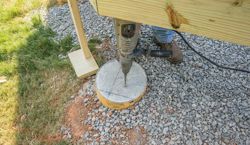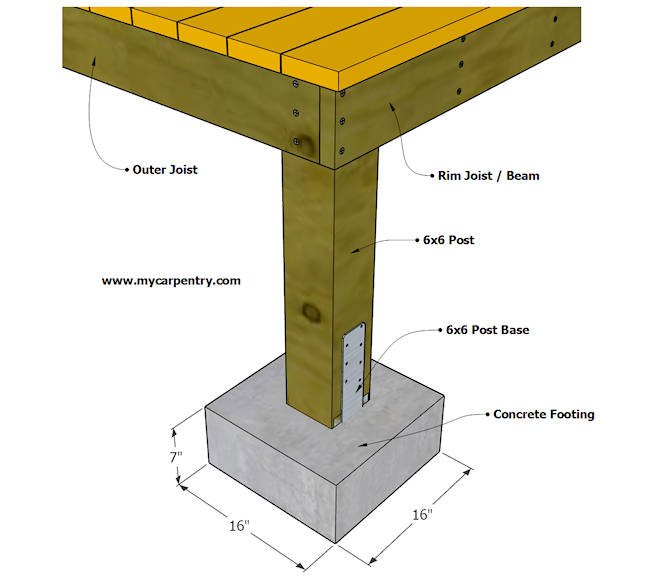Structure from scratch: The Ultimate Overview to Creating and Installing Deck Footings
Structure from scratch: The Ultimate Overview to Creating and Installing Deck Footings
Blog Article
Selecting the Right Deck Footings for Stability and Resilience
When it comes to building a deck, among one of the most essential choices you will make is choosing the appropriate grounds for stability and sturdiness. The longevity and security of your deck depend heavily on the kind of footings you pick, as they give the essential support and security to withstand the examination of time. With a myriad of choices offered, it can be overwhelming to identify which footings are best matched for your specific demands. In this conversation, we will certainly explore the numerous types of deck grounds, consider the crucial factors to evaluate when choosing, and dig right into the pros and disadvantages of different alternatives. By the end, you will have a more clear understanding of the selections available and be far better furnished to make an educated decision for your deck job.
Sorts Of Deck Grounds
There are several types of deck footings that can be utilized, each offering one-of-a-kind advantages and considerations. One common sort of ground is the concrete pier ground. These grounds include a cylindrical opening loaded with concrete, which gives a solid foundation for the deck posts. Concrete pier footings are reasonably easy to set up and offer exceptional stability, making them a prominent selection for many deck jobs.
One more kind of ground is the helical heap footing. Helical stacks are steel shafts with helical plates affixed to them. These footings are set up by screwing them right into the ground, which creates a secure structure for the deck. Helical heap grounds are suitable for locations with challenging soil problems, as they can be installed in practically any kind of kind of dirt. If needed., they likewise enable for easy modification and leveling of the deck.
Alternatively, some contractors go with precast concrete grounds. These footings are constructed from long lasting concrete and come in numerous forms and sizes to suit different deck designs. Precast concrete grounds are convenient to mount and supply a stable base for the deck framework.
Lastly, another alternative is the post-in-anchor ground system. This kind of footing includes driving a steel support into the ground and connecting it to the deck article. It uses adaptability in regards to placing the deck blog posts and appropriates for decks with lightweight frameworks.
When choosing the right kind of deck footing, it is important to think about variables such as dirt conditions, deck load, and neighborhood structure codes (Deck Footings). Consulting with an expert specialist or structural designer can assist ensure the ideal ground is chosen for a stable and risk-free deck
Elements to Think About When Choosing Footings
When picking the proper grounds for a deck, it is vital to thoroughly consider different elements such as dirt conditions, deck lots, and adherence to regional building regulations. These factors play a substantial duty in guaranteeing the stability and durability of the deck framework.
The type of soil on which the deck will be developed establishes the kind of grounds called for. On the other hand, decks built on clay or expansive soils may need grounds that can fit the soil's tendency to expand and agreement.
Another essential element is the deck tons. The weight of the deck, including the products made use of and any possible real-time lots such as furnishings or gatherings, should be taken into consideration when selecting footings. The grounds need to be made to birth the weight of the deck and disperse it equally to stop any kind of architectural problems or failures.
Lastly, adherence to neighborhood building codes is vital. Structure codes differ from region to region, and it is important to abide by the specific requirements established by the neighborhood authorities. Deck Footings. These codes make certain that the deck is constructed securely and satisfies the required requirements for structural integrity and load-bearing ability
Concrete Footings: Pros and Disadvantages

Concrete grounds offer several advantages and downsides when made use of as the structure for a deck. On the positive side, concrete footings offer outstanding security and longevity.
Another advantage of concrete footings is their versatility. check that They can be poured into different forms and dimensions to suit numerous deck layouts and arrangements. Concrete footings can be customized to fit the specific needs and requirements of the deck structure.
Nonetheless, there are additionally some downsides to making use of concrete grounds. One significant negative aspect is the price and labor associated with their installation. Concrete grounds call for excavation and usually require the aid of heavy machinery. This can enhance the overall price of the deck task and might require expert support.

Helical Piers Vs. Sonotubes: Which Is Better?
In considering see this page the foundation alternatives for a deck, the contrast in between helical piers and sonotubes is crucial in figuring out the premium selection. They are turned right into the ground using hydraulic machinery, supplying a sturdy and secure foundation for the deck.
The helical plates on the piers produce a strong grip with the dirt, stopping any activity or moving of the deck. Sonotubes, on the other hand, depend solely on the concrete filling up for stability, which might not provide the very same level of stamina and resistance.
In terms of setup, helical piers are reasonably simpler and faster to mount compared to sonotubes. The hydraulic machinery made use of to twist the piers into the ground makes certain a quick and effective procedure. Sonotubes, on the various other hand, require digging openings and pouring concrete, which can be lengthy and labor-intensive.
Furthermore, helical piers are an even more functional choice. If needed, they can be utilized in numerous dirt conditions and can be changed or enhanced. Sonotubes, on the various other hand, might require extra support, such as rebar, in specific dirt problems or locations with high load demands.
Picking the Right Footings for Your Deck's Measurements
For optimum architectural integrity, it is necessary to meticulously pick the appropriate footings that align with the dimensions of your deck. The dimensions of your deck, including its width, length, and height, play a considerable function in determining the type and size of footings needed.
When picking grounds for your deck, it is necessary to consider the load-bearing capacity of the soil. The weight of the deck, integrated with the weight of any furniture or people on it, puts in a considerable pressure on the grounds (Deck Footings). It is crucial to pick grounds that can effectively support this weight without shifting or sinking over time.
The dimension and form of the grounds must likewise be considered. Bigger decks with higher dimensions call for bigger footings to give adequate security and assistance. The shape of the grounds, whether they are square or round, relies on the style and layout of the deck. In addition, the depth at which the grounds are set up Visit Your URL should be established based upon the frost line in your region to protect against any type of heaving or moving due to freezing temperature levels.
Verdict
To conclude, choosing the right deck grounds is vital for guaranteeing stability and resilience. Variables such as the kind of grounds, the deck's dimensions, and the advantages and disadvantages of various choices should be thought about. Concrete grounds use strength and durability, but might be much more expensive and lengthy to install. Helical piers and sonotubes have their very own advantages and drawbacks. Ultimately, selecting the ideal grounds for your deck's specific demands is essential for a effective and lasting structure.
These grounds consist of a cylindrical hole filled up with concrete, which gives a strong structure for the deck posts. Concrete pier grounds are relatively very easy to set up and offer superb security, making them a popular option for numerous deck jobs.
Precast concrete footings are practical to set up and offer a stable base for the deck structure.
It offers flexibility in terms of positioning the deck posts and is ideal for decks with light-weight frameworks.
Concrete grounds provide a number of advantages and drawbacks when utilized as the foundation for a deck.
Report this page